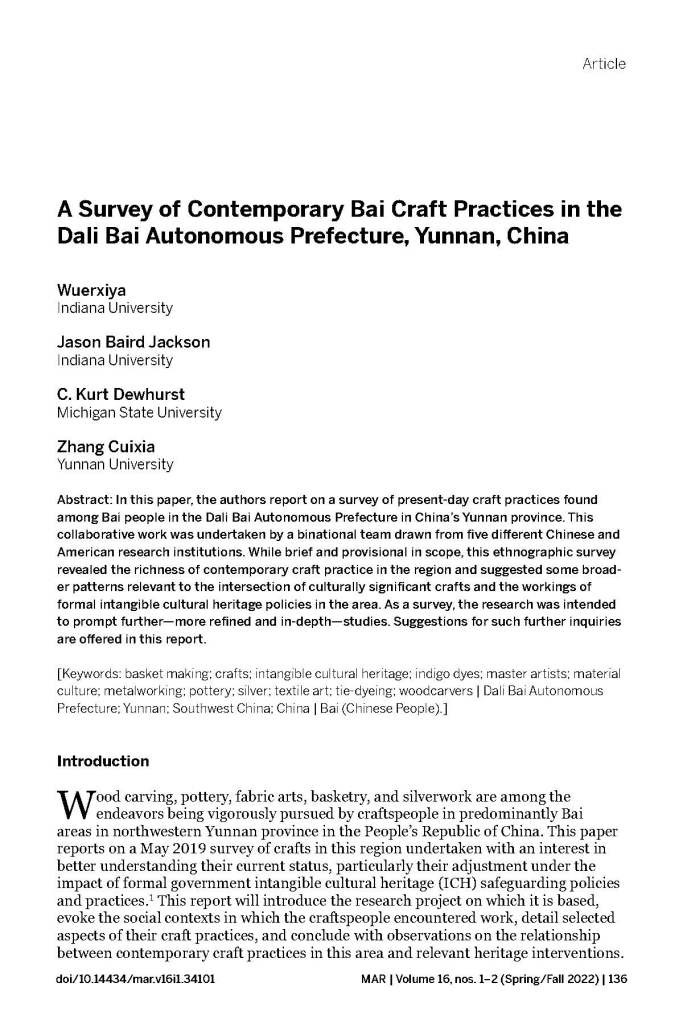Hi everyone. Some of you already know that The Michiana Potters: Art, Community, and Collaboration in the Midwest by Meredith A. E. McGriff came out recently from Indiana University Press. It’s great. You should read it asap. This is an exciting milestone not only for Meredith and her collaborators, but also for the Material Vernaculars book series that I edit for the IU Press. The Michiana Potters is the sixth title in the series. I am really happy about the work that the series is doing and I really appreciate both the IU Press and everyone who has supported the series as readers, reviewers, authors, and especially purchasers.
Why do a single out purchasers? Well, as I have noted previously, the MV series is an unusual experiment in scholarly publishing. Because those of us involved in the series want to make sure that potential readers are not hindered from reading series titles because of lack of library access or the inability to purchase the book, MV titles are offered for sale in beautiful print editions and also offered in free-to-readers editions online. When you choose to purchase one of those beautiful print books (or a commercial ebook edition), you are helping subsidize the digital free-to-readers edition. The granddaughter of one of the potters profiled in Meredith’s book, for instance, can click here and get access to the book and carry it around on her phone, show it to her art teacher, and use it for a class project. When someone who can afford to buy the book–a pottery collector getting excited about Michiana ceramics or a professor working in material culture studies, to give two obvious examples–buys the book, they are helping fund the production of the book so that others can also read and enjoy and learn from it. In fields such a folklore studies and cultural anthropology, maximizing access, especially for members of those communities from which we learn, is a crucial ethical consideration.
I have basically told this same story every time an MV title has appeared. The good news is that the system seems to be working. I hope that you will keep it working by purchasing Meredith’s fine book if you can.
As I will describe below, things are actually more complicated than I have evoked above. It is not actually the case that a book is either in print form or in the free digital form. There are other versions in the world too. Some of you can help the cause by using those other versions. I will now reveal some of these other ways.
First, the buyers. You can get a handsome paperback or hardback version of The Michiana Potters from a wide range of booksellers. The IU Press links to some of them on its webpage for the book. Pretty much any brick and mortar or online bookseller should be able to get it for you. If you are an ebook reader, you can also get an ebook edition from the usual sources of ebooks. So, book buyers, get busy. Thank you for making the series possible.
If you need or want to check out the free-to-readers edition of The Michiana Potters, it is now posted to the MV section of the IUScholarWorks repository. You can find its repository page here. If you know someone who really needs to read this or another MV title, please help them find this page. The series page with all six books in IUScholarWorks is here.
Now, lets get fancy. If you teach at a university or college and you wanted to assign The Michiana Potters or another MV title to your students, you can probably do this in a way that saves them money while also contributing financially to the work of the IU Press as the series publisher. “How can that be?” you ask. Well, series titles are also published as part of services that are relatively common in college and university libraries. One colleague of mine, for example, is teaching the inaugural series volume Material Vernaculars: Objects, Images, and Their Social Worlds this fall. Students in that colleague’s class will be reading the book via a JSTOR, a key service making journal and book content available on in university and college libraries. Other libraries have purchased eBook access using other services. For professors and students, your university library may or may not have purchased any one MV title in this form, but some have and more could. Usually all you need to do is look it up in your college or university library catalog.
So, if you are a university person, you can use a JSTOR or a university library ebook version for yourself or for your students. When you do, you are contributing, just by that use, to supporting the publishing work of IU Press, including the MV series. If you can do so, please use such library provisioned versions. They save your students money but they still help support the press. Doing so is better than pointing your students to the IUScholarWorks version. But, if you cannot arrange other access for your students or yourself, go ahead, of course, and use the Free-to-Readers version. That is what it is there for.
You can find The Michiana Potters in JSTOR here: https://www.jstor.org/stable/j.ctv14npjxm
One source that I would really like to discourage you from using are the ever growing number of dubious file sharing sites. There really is no justification for getting The Michiana Potter from a Russian hacker when the IU Press and the IU Scholarly Communications Department, both at the IU Libraries, have worked to share a safe and easy version with you.
Happy reading to everyone! Congratulations to Meredith!

The IU Press flyer promoting The Michiana Potters.










